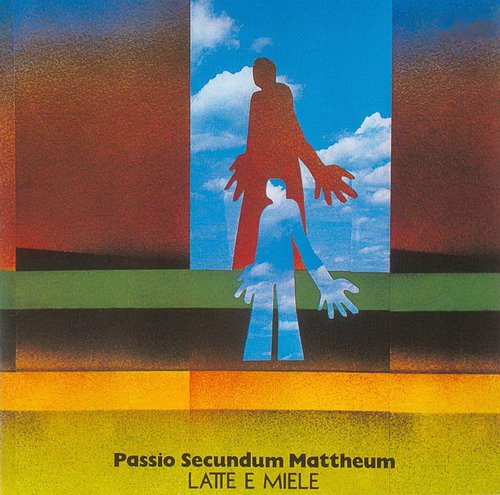|
|
|
01 |
Introduzione |
|
|
|
02:19 |
|
|
02 |
Il Giorno Degli Azzimi |
|
|
|
01:26 |
|
|
03 |
Ultima Cena |
|
|
|
01:48 |
|
|
04 |
Getzemani |
|
|
|
04:12 |
|
|
05 |
Il Processo |
|
|
|
01:29 |
|
|
06 |
I Testimoni (1' Parte) |
|
|
|
06:02 |
|
|
07 |
I Testimoni (2' Parte) |
|
|
|
02:17 |
|
|
08 |
Il Pianto |
|
|
|
01:48 |
|
|
09 |
Giuda |
|
|
|
00:43 |
|
|
10 |
Il Re Dei Giudei |
|
|
|
01:40 |
|
|
11 |
Il Calvario |
|
|
|
07:04 |
|
|
12 |
Il Dono Della Vita |
|
|
|
03:42 |
|
|
13 |
Mese Di Maggio |
|
|
|
04:24 |
|
|
|
| Country |
Italy |
| Original Release Date |
1972 |
| Cat. Number |
UICY-94503 |
| Packaging |
Jewel Case |
| Spars |
DDD |
| Sound |
Stereo |
|
|
|
Latte E Miele [Italy]
Updated 2/26/05
Discography
Passeo Secundum Mattheum (72)
Papillon (73)
Aquile E Scoiattoli (76)
Vampyrs (92, Recorded 79)
Live (92, Recorded 74)
Reviews
A trio, their great first, an album called Passio Secundum Mattheum is in the vein of Le Orme etc. but is much more varied and probably one of the best of the genre. Various styles are experienced and the resulting whole is very rewarding. Their second was also reissued in Japan, Papillon - also very good.
Very powerful classically inspired italian mid-70's band. Musically speaking probably close to RDM, but with more variance of style, more heavy and experimental. Highly recommended. The live album may be a recent recording by a reformed group. Start with Passeo.
Italian keyboard trio whose first album is supposed to be the best, but I haven't heard it yet. Papillon reveals a band that is somewhat ELP influenced yet unique, with a stronger jazz feel and creative use of orchestration a la P.F.M. The title track is in the twenty minute range and goes through various phases, the vocal sections sometimes being unbearably cute with childrens' choruses and the like, but the instrumental passages revealing the symphonic/jazzy mixture working its magic. The sixteen-minute, three-part "Patetica" quotes from the oft-quoted "Spring" concerto by Vivaldi, but otherwise is quite original symphonic prog. The two short songs give bassist/singer Oliviero Lacagnina an opportunity to stretch out on guitar. Aquile e Scoiattoli followed a dramatic lineup-shift after which only drummer Alfio Vitanza remained. Now a four-piece of guitar/bass, drums and two keyboards, surprisingly the style hadn't changed significantly except to incorporate more guitar. Note the title-song, the first half of which is all guitar and resembles acoustic Genesis, or the beautifully melodic "Menestrello", which is not unlike the lighter moments of P.F.M. or Il Volo. This album features a twenty-plus-minute epic entitled "Pavana", which is probably the reason most of you will want to buy this. Another fave song of mine: "Vacche Sacre--Falso Menestrello". My one complaint would be the screechy string-synth they use, which at times resembles the horrible Polymoog on Tormato. Still, excellent and rewarding, melodic Italian prog. Just recently released was Vampyrs, the band's previously unreleased fourth album. Supposedly more pop orientated. -- Mike Ohman
This very Italian trio barely enjoyed any success in America during the '70s. The members essentially consist of keyboardist, guitarist and drummer but their versatility assures the presence of bass, violin, flute and vocals. The compositions on Passio Secundum Mattheum, in a rock opera format, have a religious theme that is well served by the classical influences. Arrangements vary from acoustic tracks with Mellotron to heavier passages with drums, guitar, organ and synthesizer. Despite an early '70s sound, those who know what to expect from the classic italian style will not be disappointed. The Italian "classic" Papillon is amongst those that were re-edited with English vocals during the '70s. The variety of arrangements is undescribable and involves elements of classical (baroque), folk (medieval), jazz (trio) and rock (ELP). The performances show deep classical and jazz roots in contexts that range from acoustic to electric. This impressive production (for a trio) posses all the qualities to please fans of Italian symphonic rock from that era. By the time of Aquile e Scoiattoli, the band only includes the original drummer. He is joined by a bassist/guitarist, two keyboardists as well as guests on flutes, violins and saxophone. The style retains its deep classical influences and its mixture of smooth, acoustic (vocals in Italian) and heavier moments with drums, bass, organ and electric guitar. The result is a symphonic rock with strong keyboard presence and the typical Italian touch. A production that deserves attention from fans of the style and era. -- Paul Charbonneau
Links
[See Giganti, I]
